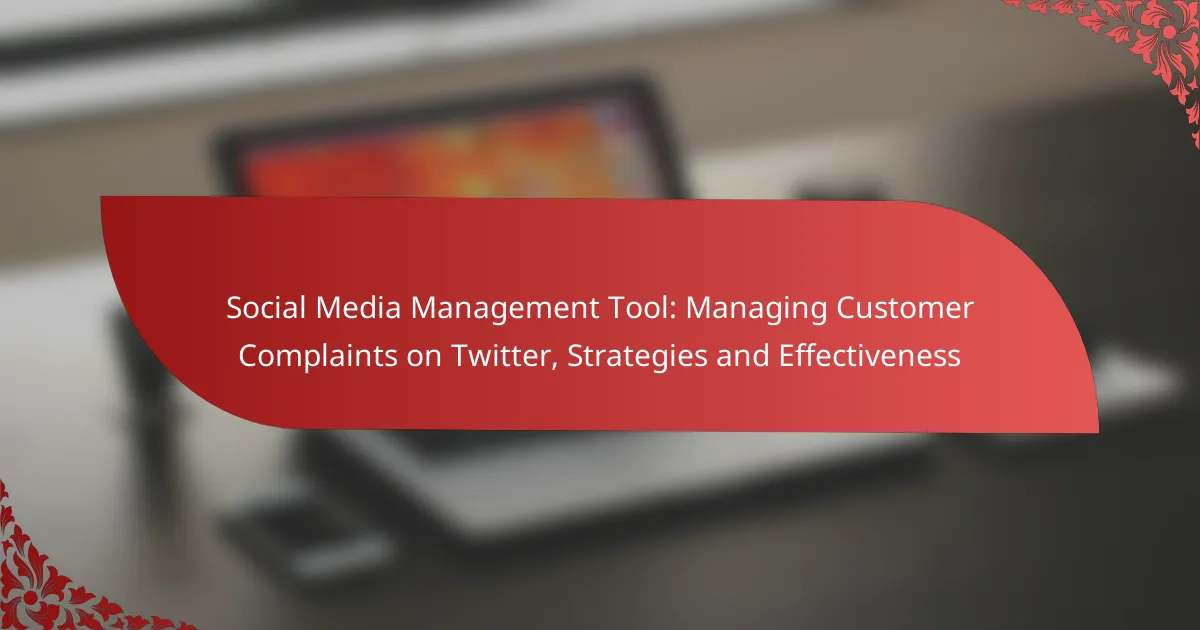In today’s digital landscape, social media management tools play a crucial role in effectively managing customer complaints on Twitter. By streamlining communication and improving response times, these tools empower businesses to monitor mentions, respond promptly, and analyze customer feedback. Implementing effective strategies such as proactive monitoring and personalized responses can significantly enhance customer satisfaction and brand reputation.
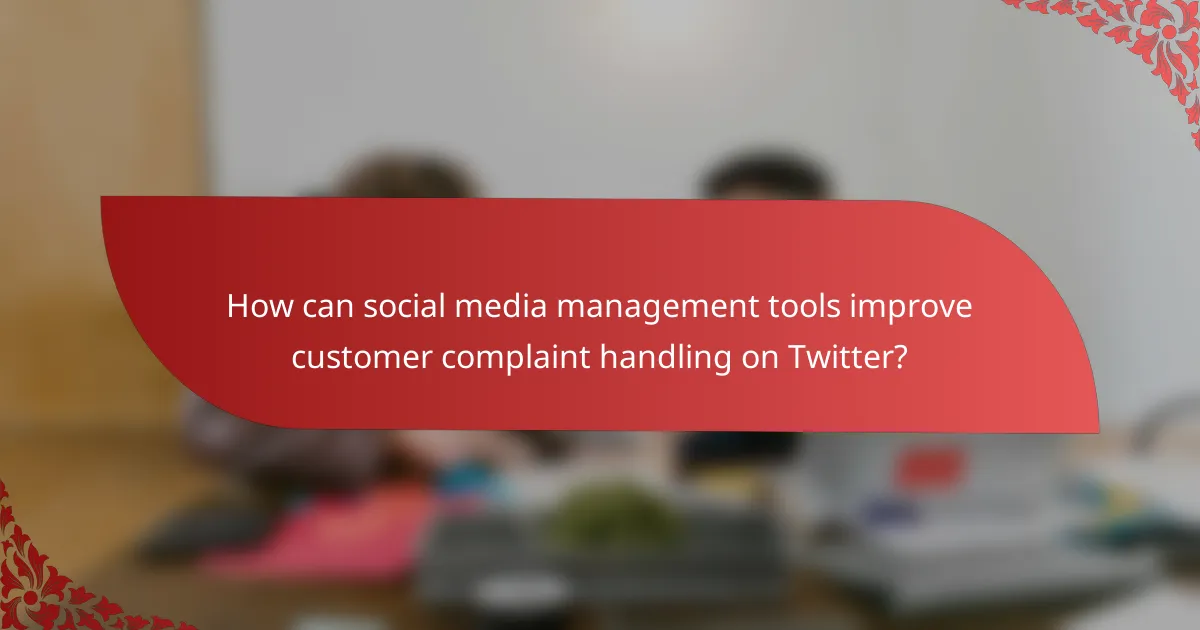
How can social media management tools improve customer complaint handling on Twitter?
Social media management tools enhance customer complaint handling on Twitter by streamlining communication, improving response times, and providing valuable insights. These tools enable businesses to monitor mentions, respond quickly, and analyze customer feedback effectively.
Enhanced response time
Improving response time is critical for effective complaint management on Twitter. Social media management tools can automate notifications for mentions and direct messages, allowing teams to respond within minutes. Quick responses can significantly increase customer satisfaction and reduce the likelihood of negative public feedback.
For instance, setting up automated replies for common queries can free up resources for more complex issues, ensuring that no complaint goes unanswered for too long. Aim for a response time of under an hour to maintain a positive brand image.
Centralized communication
Centralized communication is essential for managing customer complaints efficiently. Social media management tools consolidate messages from various platforms into a single dashboard, allowing teams to track interactions and respond without switching between applications. This reduces the risk of missed messages and ensures a consistent brand voice.
Using a centralized tool can also facilitate collaboration among team members, enabling them to share insights and strategies for handling specific complaints. Consider implementing a tagging system to categorize issues for better follow-up and resolution.
Data-driven insights
Data-driven insights from social media management tools can significantly enhance complaint handling strategies. By analyzing customer interactions and feedback, businesses can identify recurring issues and trends, allowing them to address root causes proactively. This approach can lead to improved products and services over time.
For example, tracking sentiment analysis can help teams understand how customers feel about their responses and adjust their strategies accordingly. Regularly reviewing these insights can inform training sessions and improve overall customer service effectiveness.

What are effective strategies for managing complaints on Twitter?
Effective strategies for managing complaints on Twitter include proactive monitoring, personalized responses, and clear escalation protocols. These approaches help businesses address issues swiftly, maintain customer satisfaction, and enhance their brand reputation.
Proactive monitoring
Proactive monitoring involves continuously tracking mentions of your brand on Twitter to identify complaints before they escalate. Tools like Hootsuite or TweetDeck can help you set up alerts for keywords related to your brand or products.
By monitoring conversations in real-time, you can respond promptly, often within minutes, which can significantly improve customer perceptions. Aim to check your Twitter feed several times a day, especially during peak hours or after product launches.
Personalized responses
Personalized responses are crucial for effectively managing complaints on Twitter. Addressing customers by name and acknowledging their specific issues shows that you value their concerns. For example, instead of a generic reply, say, “Hi John, I understand your frustration with our service. Let’s resolve this together.”
Always aim to provide a solution or next steps in your response. This not only helps to resolve the issue but also demonstrates your commitment to customer care, which can turn a negative experience into a positive one.
Escalation protocols
Establishing clear escalation protocols is essential for handling more complex complaints that cannot be resolved in a single interaction. Define specific criteria for when an issue should be escalated to a manager or specialist, such as repeated complaints or serious service failures.
Communicate these protocols to your team so they know how to handle various situations. For instance, if a customer expresses dissatisfaction multiple times, they should be directed to a customer service manager who can provide more in-depth assistance. This structured approach helps ensure that no complaint goes unresolved.

Which social media management tools are best for Twitter?
Several social media management tools excel at managing customer complaints on Twitter, offering features that streamline monitoring, engagement, and analytics. Hootsuite, Sprout Social, and Buffer are among the top choices, each providing unique functionalities to enhance customer service efficiency.
Hootsuite
Hootsuite is a comprehensive tool that allows users to manage multiple Twitter accounts and track customer interactions effectively. Its dashboard provides real-time monitoring of mentions and direct messages, enabling quick responses to complaints.
Key features include customizable streams for tracking specific keywords, hashtags, or user mentions, which can help identify and prioritize customer issues. Additionally, Hootsuite’s analytics tools allow businesses to measure response times and engagement rates, offering insights into customer satisfaction.
Sprout Social
Sprout Social focuses on enhancing customer engagement through its robust social listening and reporting capabilities. It allows users to categorize and respond to customer complaints efficiently, ensuring no message goes unanswered.
With features like Smart Inbox, teams can manage all incoming messages in one place, making it easier to track and resolve issues. Sprout Social also provides detailed analytics, helping businesses understand trends in customer feedback and adjust their strategies accordingly.
Buffer
Buffer is known for its simplicity and user-friendly interface, making it an excellent choice for small to medium-sized businesses. It allows users to schedule tweets and monitor engagement, which can be particularly useful for managing customer complaints during peak times.
While Buffer may not have as many advanced features as Hootsuite or Sprout Social, it offers essential tools for tracking interactions and analyzing performance. Its straightforward approach helps teams respond quickly to customer issues, ensuring timely resolutions.
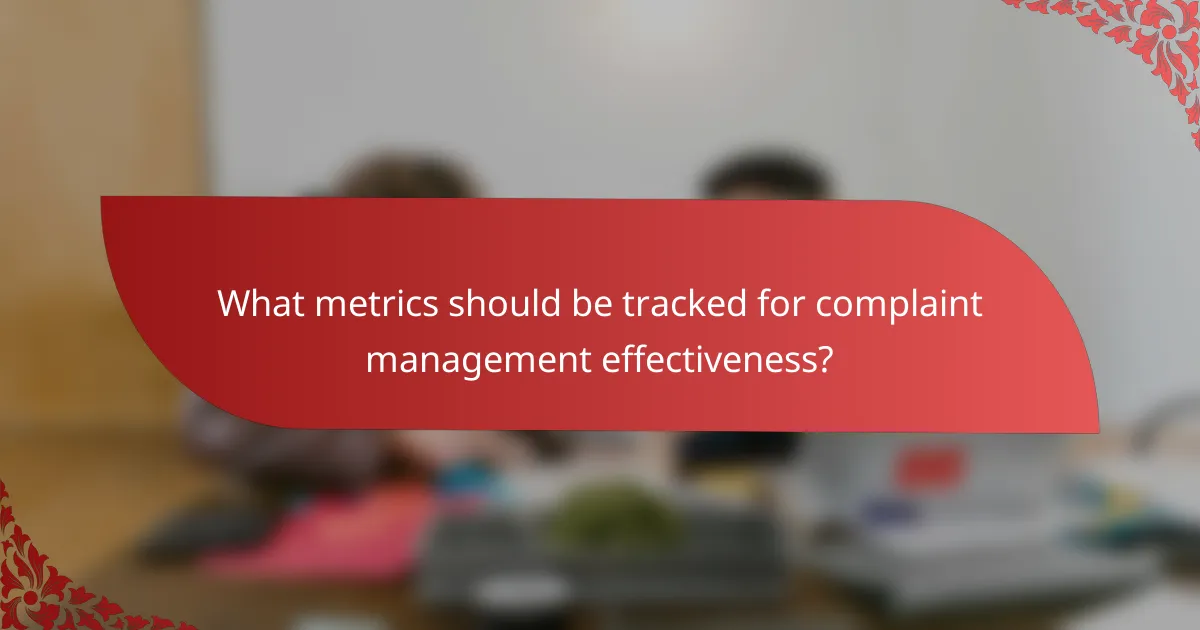
What metrics should be tracked for complaint management effectiveness?
To effectively manage customer complaints on Twitter, track metrics such as response rate, customer satisfaction score, and resolution time. These metrics provide insights into how well your team addresses issues and the overall customer experience.
Response rate
Response rate measures the percentage of customer complaints that receive a reply. A high response rate, ideally above 90%, indicates that your team is actively engaging with customers and addressing their concerns. Regularly monitoring this metric helps identify gaps in communication and ensures timely responses.
To improve your response rate, establish clear guidelines for your team on how quickly to respond to complaints. Consider using automated tools to acknowledge receipt of complaints, which can enhance customer perception while your team works on a resolution.
Customer satisfaction score
The customer satisfaction score (CSAT) gauges how satisfied customers are with the resolution of their complaints. This metric is typically collected through follow-up surveys after a complaint has been addressed. Aim for a CSAT score of 80% or higher to indicate positive customer experiences.
To effectively gather CSAT data, send brief surveys via direct messages on Twitter after resolving an issue. Keep questions straightforward and focused on the complaint resolution process to gain actionable insights.
Resolution time
Resolution time refers to the duration it takes to resolve a customer complaint from the moment it is reported. Shorter resolution times, ideally within a few hours, are associated with higher customer satisfaction. Tracking this metric helps identify inefficiencies in your complaint management process.
To optimize resolution time, categorize complaints based on their complexity and assign them to appropriate team members. Implementing a ticketing system can streamline the process and ensure that urgent issues are prioritized effectively.
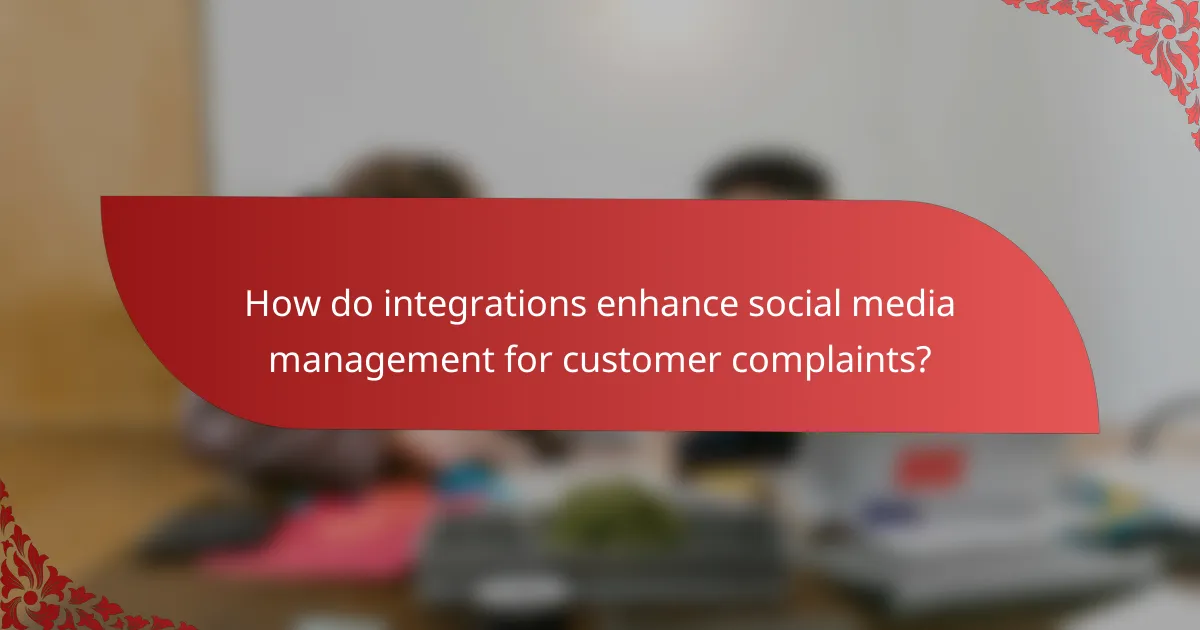
How do integrations enhance social media management for customer complaints?
Integrations significantly improve social media management for customer complaints by streamlining processes and centralizing data. They enable businesses to respond more effectively and efficiently to customer issues on platforms like Twitter.
CRM integration
Integrating Customer Relationship Management (CRM) systems with social media tools allows businesses to track customer interactions across multiple channels. This integration provides a comprehensive view of customer histories, enabling personalized responses to complaints. For instance, when a customer tweets a complaint, support teams can quickly access their purchase history and previous interactions to tailor their response.
When selecting a CRM for integration, consider options that offer robust social media capabilities, such as Salesforce or HubSpot. These platforms can help automate responses and prioritize urgent complaints based on customer value or past issues.
Analytics tools
Analytics tools integrated with social media management systems help businesses measure the effectiveness of their responses to customer complaints. By analyzing metrics such as response time, sentiment analysis, and engagement rates, companies can identify trends and areas for improvement. For example, if data shows that complaints about a specific product are rising, businesses can proactively address these issues.
Utilizing tools like Google Analytics or Hootsuite Insights can provide valuable insights into customer behavior and preferences. Regularly reviewing these analytics helps refine strategies and improve overall customer satisfaction.
Helpdesk software
Integrating helpdesk software with social media platforms allows for seamless ticketing and tracking of customer complaints. This integration ensures that all complaints received via Twitter are logged and managed in a centralized system, reducing the risk of oversight. For instance, tools like Zendesk or Freshdesk can automatically convert tweets into support tickets, allowing teams to prioritize and respond efficiently.
When implementing helpdesk software, ensure it supports multi-channel communication to maintain consistency in responses. Establishing clear workflows for escalating issues can also enhance resolution times and customer satisfaction.
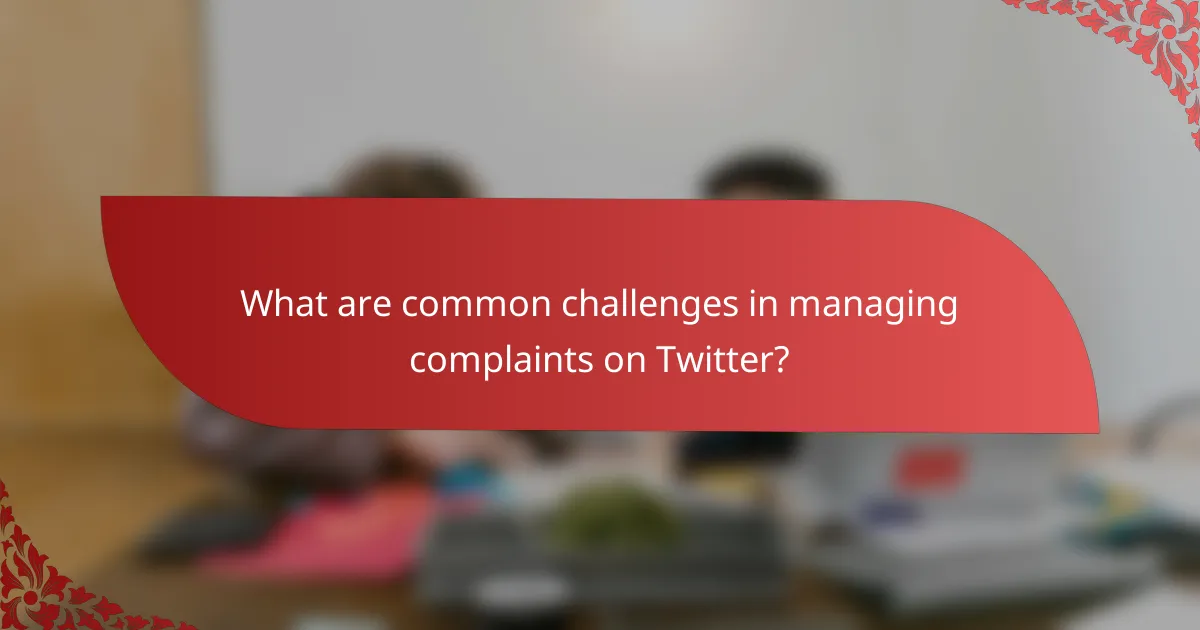
What are common challenges in managing complaints on Twitter?
Managing complaints on Twitter often involves navigating a fast-paced environment where customer expectations are high. Key challenges include handling a high volume of complaints, responding promptly, and maintaining a consistent brand voice.
High volume of complaints
The high volume of complaints on Twitter can overwhelm social media teams, especially during peak times or crises. Companies may receive hundreds or thousands of messages daily, making it difficult to address each one effectively.
To manage this influx, organizations should prioritize complaints based on urgency and impact. For instance, issues affecting a large number of customers or critical service failures should be addressed first, while less urgent matters can be handled later.
Utilizing social media management tools can streamline the process. These tools often feature automated responses, categorization of complaints, and analytics to help teams identify trends and allocate resources efficiently. Regularly reviewing complaint data can also inform proactive strategies to reduce future issues.
